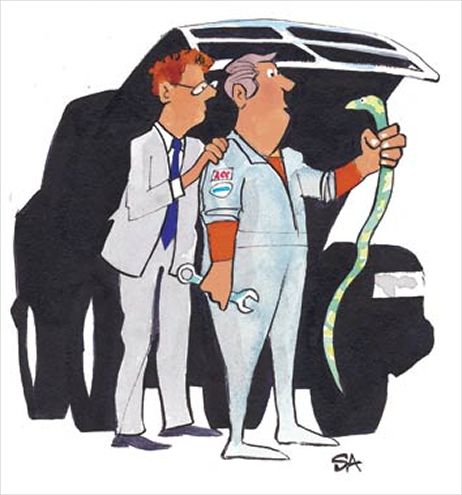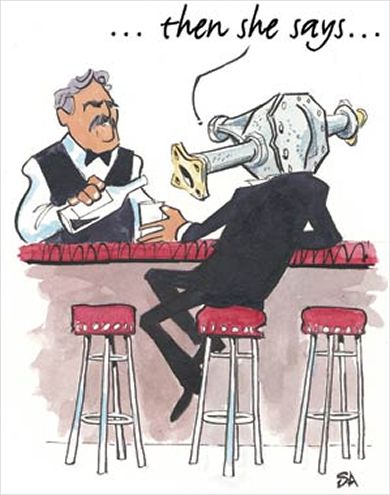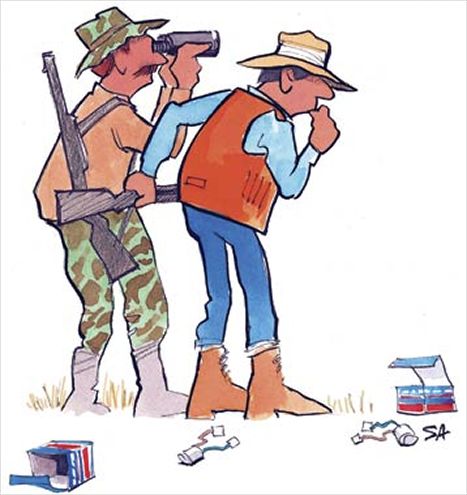Power-Steering NoisesQ:I drive a 1998 Dodge Ram with the 5.2-liter V-8. When the engine's hot, the power steering hisses, even with slight turns. I've been told the cause is the power-steering box, which costs $1000 to replace.
A:If you're not confident with the diagnosis, get a second opinion. The steering gear (box) may very well cause a hissing noise on turns. Worn or defective valves within the gear may be responsible, but keep in mind all power-steering systems normally make a certain amount of noise. Sometimes, a poor seal between the steering column and the firewall can allow steering-gear noise to enter the cab, making it seem excessive. Assuming it's indeed too noisy, you have to narrow down its origin. An electronic listening device can help determine if it's the gear or the power-steering pump, but the latter tends to produce more of a moan or growl. Always be sure the pump is filled with the correct grade of clean fluid. Signs of bubbles or aeration in the fluid may be caused by a leak in a return line. Hoses making contact with other objects under the hood also can transmit excessive noise into the passenger compartment. The most common causes of excessive power-steering noise are low fluid levels or an internal pump failure.
Three Transmissions DownQ:I bought a 1996 Dodge Ram 1500 in Miami in 1997 and had it shipped to Jamaica. Two years ago, the transmission began to squeal in overdrive. A local transmission shop suggested replacing it. I imported a remanufactured transmission, which lasted only about 15 miles. I imported a new unit, and it lasted three months. I just imported a used trans, and a different shop pointed out that an electrical connection on the transmission doesn't match the truck. There's an eight-pin plug on the transmission and a four-pin socket on the truck. Is there something missing or have I been sold the incorrect transmission three times? Dodge says my truck uses the 42RE.
A:You wrote there was an eight-pin connector on the new transmission and a four-pin on the truck. Did you get that reversed? The 42RE is a four-speed automatic transmission, and the Dodge wiring schematic shows there should be an eight-pin connector linking the transmission solenoid assembly with the powertrain control module. The 42RE is partially electronically controlled; the PCM retrieves data and sends commands to the transmission to provide the third- to fourth-gear shift and torque-converter clutch operation. The eight-pin connector enables shifting plus additional functions you can't do without; a transmission with a connector that doesn't match isn't going to work. You may be trying to install a three-speed transmission into a truck set up for a four-speed, or vice versa. Send this one back, reconfirm what transmission you're dealing with, and get the right unit. Also, be absolutely sure there's no obstruction in the transmission cooler lines or in the radiator causing repeat failures.

| 163 0506 Ttg Advice01 Z
Rear-Axle WoesQ:When my 2000 Ford Ranger recently had all its fluids replaced, the mechanic found metal shavings in the rear differential. He suspects some wear and tear and says if I keep driving the truck as is, the axle will lock up. Is that possible? The truck has 68,000 miles. He said it probably happened because I carry my motorcycle in it, but that only weighs about 550 pounds. I don't put the motorcycle in the bed of the truck anymore. He estimated the repair might cost between $350 and $700. Would it be better to get a differential at the scrap yard?A:Of all the 2000 model-year Rangers, 1540 pounds is the lowest maximum payload rating. That eliminates carrying your motorcycle as the cause of anything. Many rear-axle assemblies have a magnet mounted to the differential cover. This magnet attracts fine metal shavings caused by normal wear and should be thoroughly cleaned during a routine service. If that's what the technician was pointing to as the reason to replace the differential, don't do it. Typically, any abnormal wear in a differential assembly will cause a substantial noise (gear whine at various speeds, growling noise caused by damaged bearings, or a clunking sound from worn or loose parts). If none of these symptoms exists and only normal metal shavings were found, get a new technician and move on. Yes, a rear axle locking up can be dangerous, but the majority of the time, you'll be well aware of the problem long before it reaches that point.
Jumpy Ford GaugesQ:I have a 1994 Ford Ranger with 87,000 miles. When driving, the battery-gauge needle jumps. What does this mean?A:Typically, a failure within the charging system will display a steady decrease in battery voltage at the gauge. There can even be excessively high voltage caused by a faulty voltage regulator. The normal range is between 13.5 and 14 volts. A jumping needle could be either a poor connection somewhere in the circuits or a failure within the gauge itself--an internal part of the instrument cluster. Find an analog voltmeter and connect it to the battery to see if you get the same jumping-needle effect as the gauge on the instrument panel. If you do, there's a problem in the charging system. If it looks good, remove fuse number seven from the fuse panel under the dash and install the voltmeter from the fuse to a good metal ground (such as the doorjamb switch). If the needle jumps, there's a poor connection from the battery to the fuse (the ignition switch is part of the circuit). If the reading is normal, you'll have to remove the instrument cluster to determine if the problem is the volt gauge itself or if it's in circuits further down the line. Solving this will require the appropriate wiring diagram and some fundamental electronic aptitude.

| 163 0506 Ttg Advice02 Z

| 163 0506 Ttg Advice03 Z
Tracking a Bad SwitchQ:I purchased a new 2WD 2000 Chevy Silverado, and it now has 65,340 miles. One option I chose was rear-shock ride control, activated by a switch on the dash that dramatically stiffens the rear shocks (and the ride) when engaged. The ride-control switch is engaged at least 90 percent of the time because I like the stiffer, more positive feel it offers. It was fine for the first 32,650 miles, until the dash switch stopped working. My local Chevy dealer replaced it under warranty. At 36,050 miles, the new switch stopped working, and the dealer replaced it as well. It consistently goes belly-up about every 3200 miles. I'm now on my ninth replacement switch. I've noticed several times that the gas and temperature gauges begin to flutter slightly and read incorrectly when the switch is engaged and shortly before the switch fails. Also, at times the dash area around the switch is warm to the touch. I have repeatedly given the dealer this information, and he hasn't been able to determine the root cause.A:GM's Selective Ride Control system adjusts the damping of all four shock absorbers, not just the rear shocks. There's an electronically controlled solenoid in each shock that receives 12 volts from the switch on the dash. You may want to inspect the circuit from the switch to the solenoids, and the solenoids themselves. There may be a circuit shorting out intermittently or an internally shorted solenoid drawing excessive current through the Selective Ride switch. The switch may then burn out prior to popping the appropriate fuse. This may explain the fluttering gauges, warm switch, and repeated switch failure. Another possibility is that the switch was never the problem. Sometimes an electronic device will come back to life during diagnosis or parts replacement because a poor connection in the circuit has been disturbed. It seems fine until you're back on the road and the connection fails once more. Ask the service-department personnel to double-check for any poor connections or shorts and to check the resistance values in each shock-absorber solenoid.
Aligning All Four Wheels?Q:Is it necessary to do a four-wheel alignment on a 2002 Escalade? More important, is it possible?A:The Cadillac Escalade, along with other GM trucks on that platform (Yukon, Tahoe, Hummer H2), uses a five-link solid-axle coil-spring rear suspension. This means the wheels are mounted at a fixed position to a common solid axle, and the axle is mounted to the truck at a fixed position in line with the frame. This type of suspension normally won't include provisions for alignment-angle adjustments. An independent rear suspension, where each side of the suspension travels independently from the other, will provide rear camber and toe-in angle adjustments. This allows fine-tuning of the suspension, while keeping each side in relevant position to the other and the rear suspension in line with the front. The answer to your question is that there should be no need for a four-wheel alignment. You don't have to check the rear suspension alignment angle during normal maintenance, and there are no provisions for adjustment. However, if there are significant signs of excessive tire wear in the rear or the vehicle has been damaged during a collision, it would be a good idea to check the rear suspension angles. It may also aid in determining the extent and location of axle, suspension, or frame damage.
Looking for Hot AirQ:The heater in my 1999 ZR2 Blazer quit working. The blower operates but only discharges cool air. Do you have any suggestions?A:You should analyze the basics before getting the vehicle to a qualified repair shop. First, be sure the radiator and coolant reservoir are full. If your Blazer is equipped with a coolant temperature gauge, observe the reading after running the engine for 15 minutes. The gauge should climb to normal operating temperature. A low gauge reading may indicate that the engine's thermostat is stuck open. This would significantly diminish heater performance. Open the hood and carefully feel the two heater hoses leading through the firewall to the heater core under the dash. The hoses should be hot. Insufficient temperature at the hoses indicates a restriction in coolant delivery from the engine. Hot hoses would steer you toward a temperature-control problem within the system under the dash. There have been problems with coolant-system rust buildup on certain GM SUVs that may hamper coolant flow and cause an overheat and/or heater performance problem. In this case, GM TSB #99-06-02-012D gives a detailed coolant-system inspection and flushing procedure.
Airbag Replacement TipsQ:My 1996 GMC Sierra deployed an airbag, and I can't get a straight answer as to what parts I need to replace. A low-speed collision triggered the deployment, and the frame-rail sensor wasn't damaged. I've been told there's a sensor under the seat that has to be replaced, but I can't find it. Is there a way to ohm the frame-rail sensor to check? Will the new bag deploy if I've overlooked something and reconnect the power? Can the computer diagnose what I need to replace? I've already purchased some of the parts, which came from a rollover I located at a salvage yard. The local dealership wants a fortune for everything new.A:There are three sensors: an arming sensor inside the left frame rail below the driver's door and two discriminating sensors outside the left and right front frame rails. These sensors measure sudden changes in vehicle speed and direct airbag deployment. Once an airbag is deployed, the recommended procedure is to repair all structural damage and replace the airbag and any sensors in the area of the damage, even if they appear to be in working condition. Always disconnect the battery and wait two minutes for the system to discharge to avoid accidental deployment during service. There is no sensor under the seat--the module controlling the system is under the dash. Any mounting brackets that were bent in the collision also should be replaced. Next, do a full inspection of the steering column and supplemental inflatable restraint system wiring within the column. The proper scan tool is needed to clear trouble codes from the memory and turn off the airbag warning light. It should go without saying that it's always best to have a trained professional perform this type of work. Not surprisingly, General Motors strongly advises against the use of SIR system parts from another vehicle. There may be hidden internal differences or damage.

| 163 0506 Ttg Advice04 Z
 | 163 0506 Ttg Advice01 Z
Rear-Axle Woes
| 163 0506 Ttg Advice01 Z
Rear-Axle Woes | 163 0506 Ttg Advice02 Z
| 163 0506 Ttg Advice02 Z
 | 163 0506 Ttg Advice03 Z
Tracking a Bad Switch
| 163 0506 Ttg Advice03 Z
Tracking a Bad Switch | 163 0506 Ttg Advice04 Z
| 163 0506 Ttg Advice04 Z